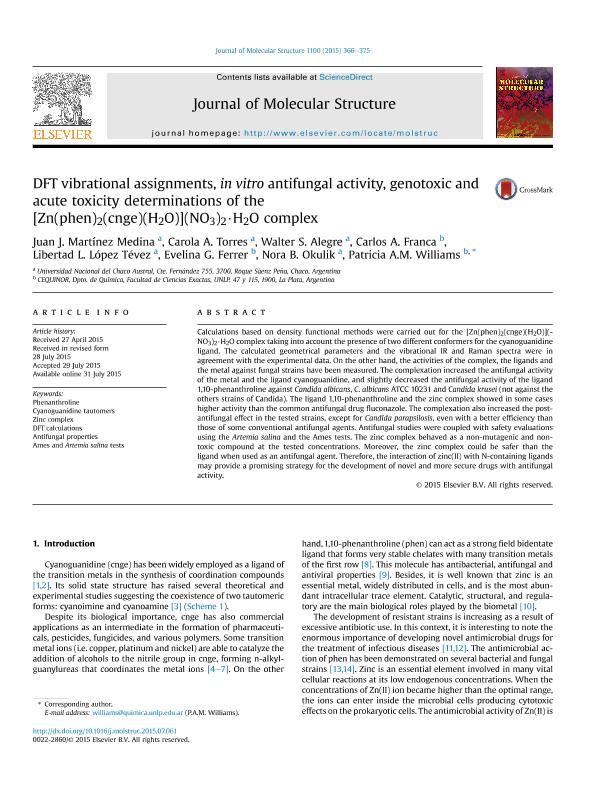Mostrar el registro sencillo del ítem
dc.contributor.author
Martínez Medina, Juan José

dc.contributor.author
Torres, Carola Analía

dc.contributor.author
Alegre, Walter S.
dc.contributor.author
Franca, Carlos Alberto

dc.contributor.author
López Tévez, Libertad Leonor

dc.contributor.author
Ferrer, Evelina Gloria

dc.contributor.author
Okulik, Nora Beatriz

dc.contributor.author
Williams, Patricia Ana María

dc.date.available
2018-02-27T17:07:55Z
dc.date.issued
2015-08
dc.identifier.citation
Martínez Medina, Juan José; Torres, Carola Analía; Alegre, Walter S.; Franca, Carlos Alberto; López Tévez, Libertad Leonor; et al.; DFT vibrational assignments, in vitro antifungal activity, genotoxic and acute toxicity determinations of the [Zn(phen)2(cnge)(H2O)](NO3)2·H2O complex; Elsevier Science; Journal of Molecular Structure; 1100; 8-2015; 366-375
dc.identifier.issn
0022-2860
dc.identifier.uri
http://hdl.handle.net/11336/37267
dc.description.abstract
Calculations based on density functional methods were carried out for the [Zn(phen)2(cnge)(H2O)](NO3)2·H2O complex taking into account the presence of two different conformers for the cyanoguanidine ligand. The calculated geometrical parameters and the vibrational IR and Raman spectra were in agreement with the experimental data. On the other hand, the activities of the complex, the ligands and the metal against fungal strains have been measured. The complexation increased the antifungal activity of the metal and the ligand cyanoguanidine, and slightly decreased the antifungal activity of the ligand 1,10-phenanthroline against Candida albicans, C. albicans ATCC 10231 and Candida krusei (not against the others strains of Candida). The ligand 1,10-phenanthroline and the zinc complex showed in some cases higher activity than the common antifungal drug fluconazole. The complexation also increased the post-antifungal effect in the tested strains, except for Candida parapsilosis, even with a better efficiency than those of some conventional antifungal agents. Antifungal studies were coupled with safety evaluations using the Artemia salina and the Ames tests. The zinc complex behaved as a non-mutagenic and non-toxic compound at the tested concentrations. Moreover, the zinc complex could be safer than the ligand when used as an antifungal agent. Therefore, the interaction of zinc(II) with N-containing ligands may provide a promising strategy for the development of novel and more secure drugs with antifungal activity.
dc.format
application/pdf
dc.language.iso
eng
dc.publisher
Elsevier Science

dc.rights
info:eu-repo/semantics/openAccess
dc.rights.uri
https://creativecommons.org/licenses/by-nc-sa/2.5/ar/
dc.subject
Ames And Artemia Salina Tests
dc.subject
Antifungal Properties
dc.subject
Cyanoguanidine Tautomers
dc.subject
Dft Calculations
dc.subject
Phenanthroline
dc.subject
Zinc Complex
dc.subject.classification
Otras Ciencias Químicas

dc.subject.classification
Ciencias Químicas

dc.subject.classification
CIENCIAS NATURALES Y EXACTAS

dc.title
DFT vibrational assignments, in vitro antifungal activity, genotoxic and acute toxicity determinations of the [Zn(phen)2(cnge)(H2O)](NO3)2·H2O complex
dc.type
info:eu-repo/semantics/article
dc.type
info:ar-repo/semantics/artículo
dc.type
info:eu-repo/semantics/publishedVersion
dc.date.updated
2018-02-22T21:04:09Z
dc.identifier.eissn
1872-8014
dc.journal.volume
1100
dc.journal.pagination
366-375
dc.journal.pais
Países Bajos

dc.journal.ciudad
Amsterdam
dc.description.fil
Fil: Martínez Medina, Juan José. Universidad Nacional del Chaco Austral. Departamento de Ciencias Basicas y Aplicadas; Argentina. Consejo Nacional de Investigaciones Científicas y Técnicas; Argentina
dc.description.fil
Fil: Torres, Carola Analía. Universidad Nacional del Chaco Austral. Departamento de Ciencias Basicas y Aplicadas; Argentina. Consejo Nacional de Investigaciones Científicas y Técnicas; Argentina
dc.description.fil
Fil: Alegre, Walter S.. Universidad Nacional del Chaco Austral. Departamento de Ciencias Basicas y Aplicadas; Argentina
dc.description.fil
Fil: Franca, Carlos Alberto. Consejo Nacional de Investigaciones Científicas y Técnicas. Centro Científico Tecnológico Conicet - La Plata. Centro de Química Inorgánica "Dr. Pedro J. Aymonino". Universidad Nacional de La Plata. Facultad de Ciencias Exactas. Centro de Química Inorgánica "Dr. Pedro J. Aymonino"; Argentina
dc.description.fil
Fil: López Tévez, Libertad Leonor. Universidad Nacional del Chaco Austral. Departamento de Ciencias Basicas y Aplicadas; Argentina
dc.description.fil
Fil: Ferrer, Evelina Gloria. Consejo Nacional de Investigaciones Científicas y Técnicas. Centro Científico Tecnológico Conicet - La Plata. Centro de Química Inorgánica "Dr. Pedro J. Aymonino". Universidad Nacional de La Plata. Facultad de Ciencias Exactas. Centro de Química Inorgánica "Dr. Pedro J. Aymonino"; Argentina
dc.description.fil
Fil: Okulik, Nora Beatriz. Universidad Nacional del Chaco Austral. Departamento de Ciencias Basicas y Aplicadas; Argentina. Consejo Nacional de Investigaciones Científicas y Técnicas; Argentina
dc.description.fil
Fil: Williams, Patricia Ana María. Consejo Nacional de Investigaciones Científicas y Técnicas. Centro Científico Tecnológico Conicet - La Plata. Centro de Química Inorgánica "Dr. Pedro J. Aymonino". Universidad Nacional de La Plata. Facultad de Ciencias Exactas. Centro de Química Inorgánica "Dr. Pedro J. Aymonino"; Argentina
dc.journal.title
Journal of Molecular Structure

dc.relation.alternativeid
info:eu-repo/semantics/altIdentifier/url/http://www.sciencedirect.com/science/article/pii/S0022286015301721
dc.relation.alternativeid
info:eu-repo/semantics/altIdentifier/doi/https://doi.org/10.1016/j.molstruc.2015.07.061
Archivos asociados
